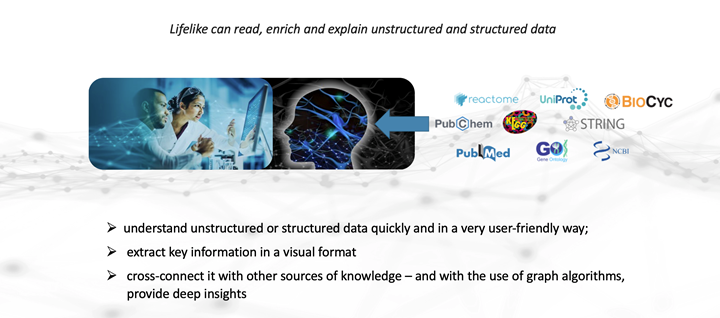Lifelike is a graph-powered knowledge mining and data storytelling platform, being developed by a multi-disciplinary team with diverse specialties in software, data engineering and graph analytics. The team is geographically dispersed between the University of California San Diego and Technical University of Denmark.
Our mission is to enable scientist to easily reuse knowledge that is generated through publications or available in public databases and enable them to generate new knowledge in a format that is more suitable for humans and machines to work together in solving problems. We believe if we can enable machines and humans to reuse knowledge effectively, then we can reach a new level of organizational wisdom that can accelerate research.
Large amounts of data are generated at an unprecedented rate. The data is then analyzed and translated into knowledge. While a lot of tools and techniques for data management and analysis have been developed, the management of the derived knowledge is less established. Critical information exists in unstructured formats such as PDFs, presentation slides, publications or is spread over many siloed public databases or web sites. This makes it difficult for humans and computer to consume knowledge, understand it quickly and cross-connect it with other sources of information.
“We are drowning in information but starved for
knowledge.” -John Naisbitt
Lifelike addresses this problem with machine learning, natural language processing and knowledge graphs. It consolidates data from various public databases, such as PubMed, NCBI, PubChem, ChEBI, UniProt, String DB, GO ontology, BioCyc, Kegg, etc. into one unified single knowledge base, allowing scientists to discover and explain new unintuitive connections and insights. Users can upload any PDF and Lifelike will detect entities from the text, classify them into different categories (such as genes, proteins, diseases, chemicals, phenotypes, etc.) and link them to public databases where further information can be retrieved. The named entities as well as text snippets can be dragged to a canvas for knowledge reconstruction and data story telling.
Users can also upload structured data, such as a list of genes and Lifelike will enrich the data against the many public databases that are integrated as a knowledge graph. Multiple omics data types can be analyzed and contextualized against the knowledge graph utilizing path finding and centrality algorithms. Special visualization techniques support the interpretation of complex relationships. The ability to contextualize data against a highly integrated knowledge base, enables users to derive big insights from even small data sets.
For more information please visit the Lifelike website.
